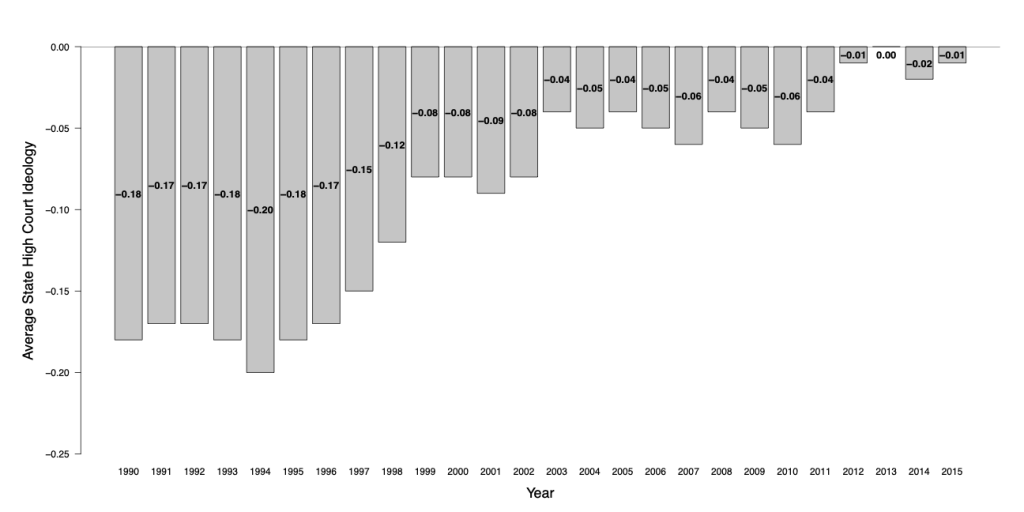I am pleased to welcome to ELB Book Corner James L. Gibson and Michael J. Nelson, authors of the new book, Judging Inequality: State Supreme Courts and the Inequality Crisis. (Readers using this link and the code JUDGING get a 20 percent discount.) Here is their second of three posts:

In our previous post, we discussed a core finding from our new book, Judging Inequality. Based on an analysis of nearly 6,000 equality-relevant cases decided in state supreme courts between 1990 and 2015, we found that state supreme courts issued approximately equal proportions of pro- and anti-equality decisions. Yet, this topline number masks enormous variation in the propensity of particular state high courts to support equality: states like Texas are particularly unlikely to issue pro-equality decisions; the opposite is true in New Jersey.
But the decisions of state high courts are made by judges. Understanding the background characteristics of these judges is essential to understanding the willingness of state high courts to strike down restrictions on voting, to support the rights of same-sex couples, and to provide citizens with full access to justice. Armed with the support of the Russell Sage Foundation and the National Science Foundation, we worked with a team of research assistants to code the background characteristics of nearly 1,000 people who served as full-time judges on the supreme courts in each state during our twenty-six year time period.
Political scientists have long been interested in the relationship between judicial ideology and judicial behavior, so we began our analysis of judge-level behavior in these equality-relevant cases by examining this connection. Based on news articles, ballot designations, and obituaries, we were able to score each judge in our database as either a Democrat or a Republican. Overall, Democrats dominated; about 56 percent of the judges are Democrats and the remaining 44 percent are Republicans.
The conventional wisdom is that Democrats tend to be at least somewhat liberal and that Republicans tend to be at least somewhat conservative. That assumption, however, is subject to some necessary empirical verification. To validate this assumption, we refer to the work of Bonica and Woodruff, who have developed a measure of state supreme court judges’ ideologies that is useful for us. The measure is derived from a mixture of campaign contributions data and the party of the appointing authority (typically, the governor). We find a large partisan difference in ideology according to the judges’ party affiliation: the difference between the average Republican justice and the average Democrat is about two standard deviations, a very large difference indeed
Armed with these data, we can assess change in the make-up of state supreme courts over time. Figure 1 displays the average ideology of the 50 state supreme courts with civil jurisdiction between 1990 and 2015. Lower (more negative) values indicate greater liberalism. The ideology scores are relative, not absolute scores, so zero has no inherent or substantive meaning. That these bars get closer to the zero line over time demonstrates that the state supreme courts have become considerably more conservative from 1990 to 2015. In the early part of the time series, the courts tilted toward the liberal end of the spectrum. At the end of the time series, this tilt righted itself, producing ideological parity between liberal and conservative state high court judges. As to political party attachments, the average state supreme court in 1990 was 34 percent Republican. By 2000, this figure increased to 45 percent. By 2015, the average state high court was 54 percent Republican.

Figure 1: The average percentage ideology of state supreme courts, by year.
How well does our measure of ideology predict judges’ votes in equality relevant cases?
Figure 2 shows the relationship between judicial ideology and judicial behavior in our dataset. Perhaps unsurprisingly, there is a noticeable negative relationship between ideology and judges’ willingness to support equality. Even without accounting for differences in states, cases, or time, knowing that a judge is liberal or conservative is enough to predict with some degree of confidence how that judge is likely to decide an equality-relevant case.

Figure 2: The relationship between the ideology of state supreme court justices and the percentage of equality-relevant cases in which they voted in a pro-equality direction. The figure is limited to justices who decided at least 10 cases in our dataset.
This research was conducted with the support of the National Science Foundation (SES-1456568 and SES-1456580) and the Russell Sage Foundation (G-1962). Any opinions, findings, and conclusions or recommendations expressed here are the authors’ alone and do not necessarily reflect the views of the National Science Foundation or of the Russell Sage Foundation.